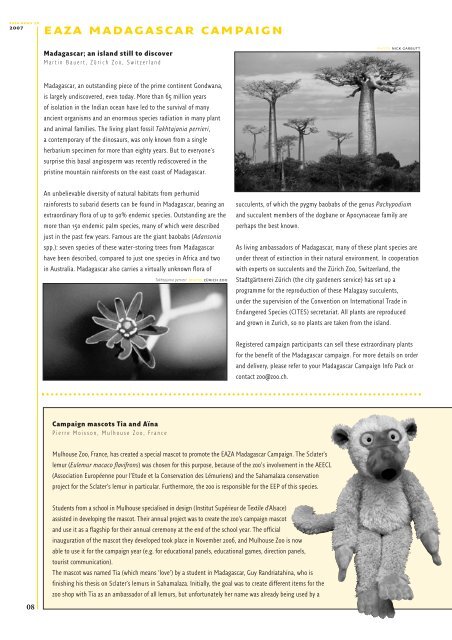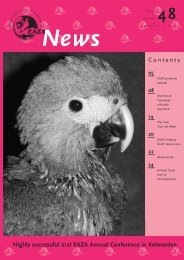EAZA News 58-9 - European Association of Zoos and Aquaria
EAZA News 58-9 - European Association of Zoos and Aquaria
EAZA News 58-9 - European Association of Zoos and Aquaria
You also want an ePaper? Increase the reach of your titles
YUMPU automatically turns print PDFs into web optimized ePapers that Google loves.
eaza news <strong>58</strong><br />
2007<br />
08<br />
eaza madagascar campaign<br />
Madagascar; an isl<strong>and</strong> still to discover<br />
Martin Bauert, Zürich Zoo, Switzerl<strong>and</strong><br />
Madagascar, an outst<strong>and</strong>ing piece <strong>of</strong> the prime continent Gondwana,<br />
is largely undiscovered, even today. More than 65 million years<br />
<strong>of</strong> isolation in the Indian ocean have led to the survival <strong>of</strong> many<br />
ancient organisms <strong>and</strong> an enormous species radiation in many plant<br />
<strong>and</strong> animal families. The living plant fossil Takhtajania perrieri,<br />
a contemporary <strong>of</strong> the dinosaurs, was only known from a single<br />
herbarium specimen for more than eighty years. But to everyone's<br />
surprise this basal angiosperm was recently rediscovered in the<br />
pristine mountain rainforests on the east coast <strong>of</strong> Madagascar.<br />
An unbelievable diversity <strong>of</strong> natural habitats from perhumid<br />
rainforests to subarid deserts can be found in Madagascar, bearing an<br />
extraordinary flora <strong>of</strong> up to 90% endemic species. Outst<strong>and</strong>ing are the<br />
more than 150 endemic palm species, many <strong>of</strong> which were described<br />
just in the past few years. Famous are the giant baobabs (Adansonia<br />
spp.): seven species <strong>of</strong> these water-storing trees from Madagascar<br />
have been described, compared to just one species in Africa <strong>and</strong> two<br />
in Australia. Madagascar also carries a virtually unknown flora <strong>of</strong><br />
Campaign mascots Tia <strong>and</strong> Aïna<br />
Pierre Moisson, Mulhouse Zoo, France<br />
Takhtajania perrieri photo zürich zoo<br />
succulents, <strong>of</strong> which the pygmy baobabs <strong>of</strong> the genus Pachypodium<br />
<strong>and</strong> succulent members <strong>of</strong> the dogbane or Apocynaceae family are<br />
perhaps the best known.<br />
As living ambassadors <strong>of</strong> Madagascar, many <strong>of</strong> these plant species are<br />
under threat <strong>of</strong> extinction in their natural environment. In cooperation<br />
with experts on succulents <strong>and</strong> the Zürich Zoo, Switzerl<strong>and</strong>, the<br />
Stadtgärtnerei Zürich (the city gardeners service) has set up a<br />
programme for the reproduction <strong>of</strong> these Malagasy succulents,<br />
under the supervision <strong>of</strong> the Convention on International Trade in<br />
Endangered Species (CITES) secretariat. All plants are reproduced<br />
<strong>and</strong> grown in Zurich, so no plants are taken from the isl<strong>and</strong>.<br />
Registered campaign participants can sell these extraordinary plants<br />
for the benefit <strong>of</strong> the Madagascar campaign. For more details on order<br />
<strong>and</strong> delivery, please refer to your Madagascar Campaign Info Pack or<br />
contact zoo@zoo.ch.<br />
Mulhouse Zoo, France, has created a special mascot to promote the <strong>EAZA</strong> Madagascar Campaign. The Sclater’s<br />
lemur (Eulemur macaco flavifrons) was chosen for this purpose, because <strong>of</strong> the zoo’s involvement in the AEECL<br />
(<strong>Association</strong> Européenne pour l’Etude et la Conservation des Lémuriens) <strong>and</strong> the Sahamalaza conservation<br />
project for the Sclater’s lemur in particular. Furthermore, the zoo is responsible for the EEP <strong>of</strong> this species.<br />
Students from a school in Mulhouse specialised in design (Institut Supérieur de Textile d’Alsace)<br />
assisted in developing the mascot. Their annual project was to create the zoo’s campaign mascot<br />
<strong>and</strong> use it as a flagship for their annual ceremony at the end <strong>of</strong> the school year. The <strong>of</strong>ficial<br />
inauguration <strong>of</strong> the mascot they developed took place in November 2006, <strong>and</strong> Mulhouse Zoo is now<br />
able to use it for the campaign year (e.g. for educational panels, educational games, direction panels,<br />
tourist communication).<br />
The mascot was named Tia (which means ‘love’) by a student in Madagascar, Guy R<strong>and</strong>riatahina, who is<br />
finishing his thesis on Sclater’s lemurs in Sahamalaza. Initially, the goal was to create different items for the<br />
zoo shop with Tia as an ambassador <strong>of</strong> all lemurs, but unfortunately her name was already being used by a<br />
photo nick garbutt

















